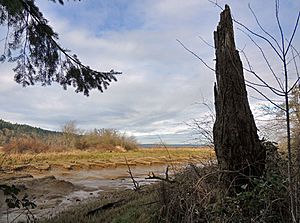Treaty of Medicine Creek facts for kids
The Treaty of Medicine Creek was an important agreement signed in 1854 between the United States government and nine different Native American tribes and groups. These tribes lived around the Puget Sound area in what is now Washington. The tribes included the Nisqually, Puyallup, Squaxin Island, and others. The treaty was signed on December 26, 1854, by Isaac Stevens, who was the governor of the Washington Territory at the time. He signed it along with the chiefs and leaders from the Native American tribes. For the treaty, these tribes were treated as one group.
Why the Treaty Happened
Isaac Stevens was the governor of Washington Territory in 1854. He was in charge of all matters involving Native Americans, including making treaties to get land for the United States government. In December 1854, Governor Stevens called a meeting with the Native American tribes living in the South Puget Sound area. He was especially interested in these tribes because they were known as good workers and excellent fishermen. They also controlled a lot of the trade in the area. The main tribes included the Puyallup, the Muckleshoot, and the Nisqually.
Governor Stevens hired George Gibbs to help him negotiate the treaty. Gibbs had traveled west before and knew a lot about the Native American people. The Native Americans were told that the treaty would help them by paying them for some of their land. However, the treaty ended up taking away their best farmland. It also moved the tribes to reservations that were often not very good for living or farming.
Chief Leschi of the Nisqually tribe was very unhappy about the treaty. He and his people marched to Olympia to share their concerns, but Governor Stevens told them to leave. When the Native Americans refused to go, Governor Stevens eventually declared a special law called martial law. Later, after a conflict known as the Puget Sound War began in 1855, he ordered Chief Leschi to be arrested. Chief Leschi was eventually captured and put on trial. The first jury could not decide if he was guilty. So, Governor Stevens had a second trial. This time, Chief Leschi was found guilty. Sadly, Chief Leschi was executed on February 19, 1858. Years later, in 2004, it was officially recognized that he was innocent.
Where the Treaty Was Signed
The treaty was signed near the Nisqually River delta, next to a creek. The Native Americans called this creek She-nah-num, but white settlers called it Medicine Creek. Today, it is known as McAllister Creek.
The signing happened in Thurston County, Washington, on December 26, 1854. It took place in a group of Douglas fir trees that were well known to the tribes. One special tree from that original group, known as the Treaty Tree, became a monument. On June 14, 1922, a group called the Daughters of the American Revolution placed a bronze plaque on the Treaty Tree. The plaque said that this was the site of the Medicine Creek Treaty. Even though it wasn't an official historical site, the area was avoided when Interstate 5 was built in the 1960s.
In 1976, students from Timberline High School built a monument on the hillside overlooking the creek. This monument points to the treaty site. From the air, the monument looks like a peace sign. It includes an old Navy buoy, which represents the Native American way of thinking in a full circle. It also has a rusty railroad rail, which represents the straight-line thinking of the white settlers. There is also a time capsule inside, set to be opened in 2076.
The original plaque from the Daughters of the American Revolution disappeared in the 1970s. The large Treaty Tree itself became sick by 1975 and died by 1979. However, seeds from the Treaty Tree were collected in the 1970s and planted in a circle about 40 feet away. The dead part of the original tree stayed standing until 2007, when it finally fell during strong windstorms.
In June 2013, a new plaque was placed in front of a tree that grew from a seedling of the last Treaty Tree. This new tree is growing on the bluff of the Thurston County Courthouse campus. Leaders from the local treaty tribes and Thurston County officials came together for the dedication ceremony. The new plaque explains that the Treaty of Medicine Creek was signed there in 1854. It also says that the new living trees stand as a reminder of the promises made in the treaty.
Today, the site is part of the Billy Frank Jr. Nisqually National Wildlife Refuge. In 2015, the United States Congress officially named it the Medicine Creek Treaty National Memorial. You can only reach it by boat, going up McAllister Creek.
What the Treaty Said
The treaty gave 2.24 million acres of land to the United States government. In return, it set up three reservations for the tribes. The tribes also received cash payments over twenty years. The treaty also recognized the tribes' traditional rights to fishing and hunting on their lands.
The exact meaning of these fishing and hunting rights was argued for many years. This argument continued until a court decision in 1974 called the Boldt Decision. After this decision, the tribes named in the treaty were officially recognized as having the right to half of the fish caught on their traditional lands throughout south Puget Sound. Before this decision, state and territorial governments had allowed the tribes much less.
The original Nisqually reservation, set up by the treaty, was on rocky land. This was not good for the Nisqually people, who were known for fishing along rivers. Because of this, they went to war in 1855. A sad result of the conflicts that followed was that Nisqually Chief Leschi was executed. As mentioned before, he was later proven innocent in 2004.


